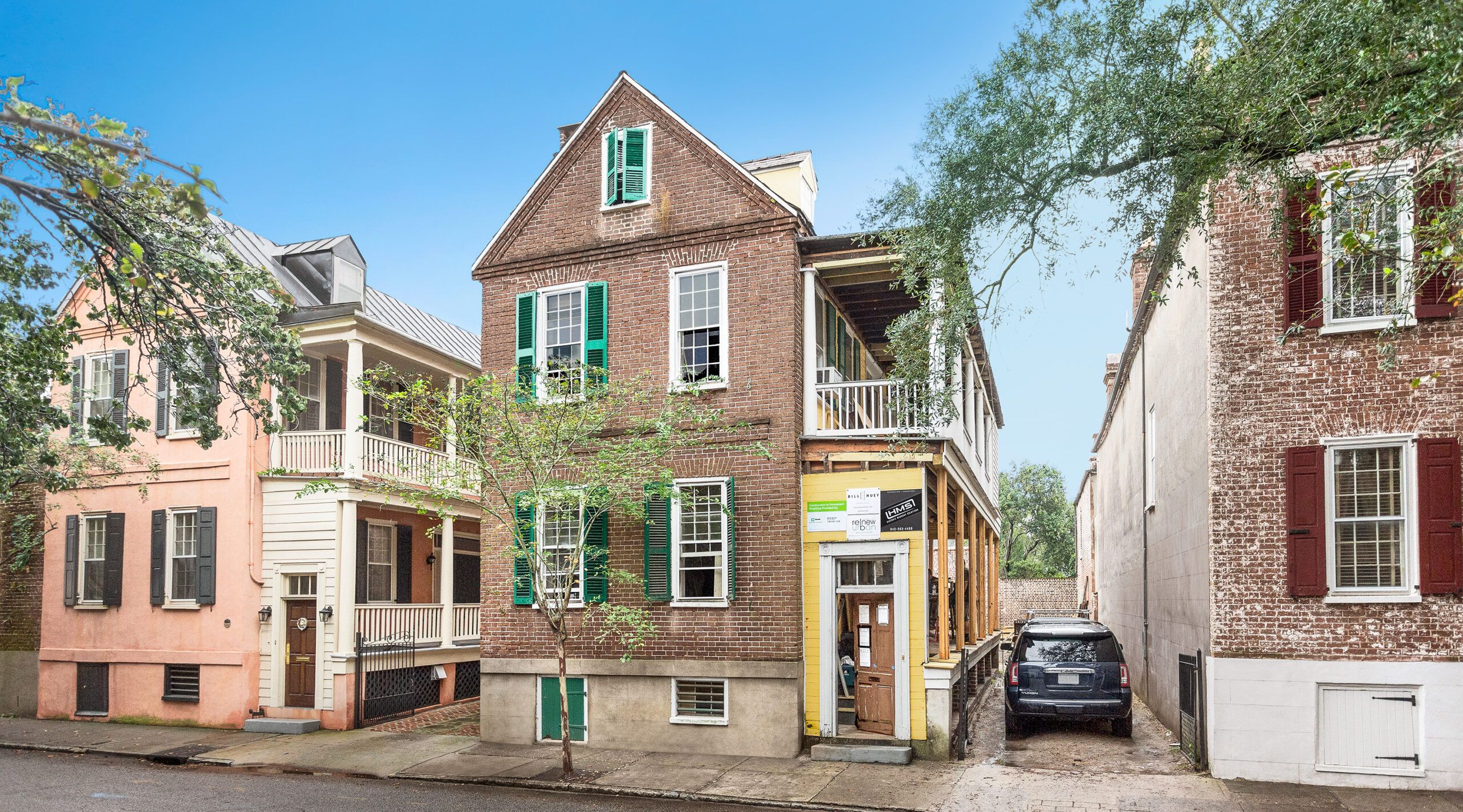Built to Last
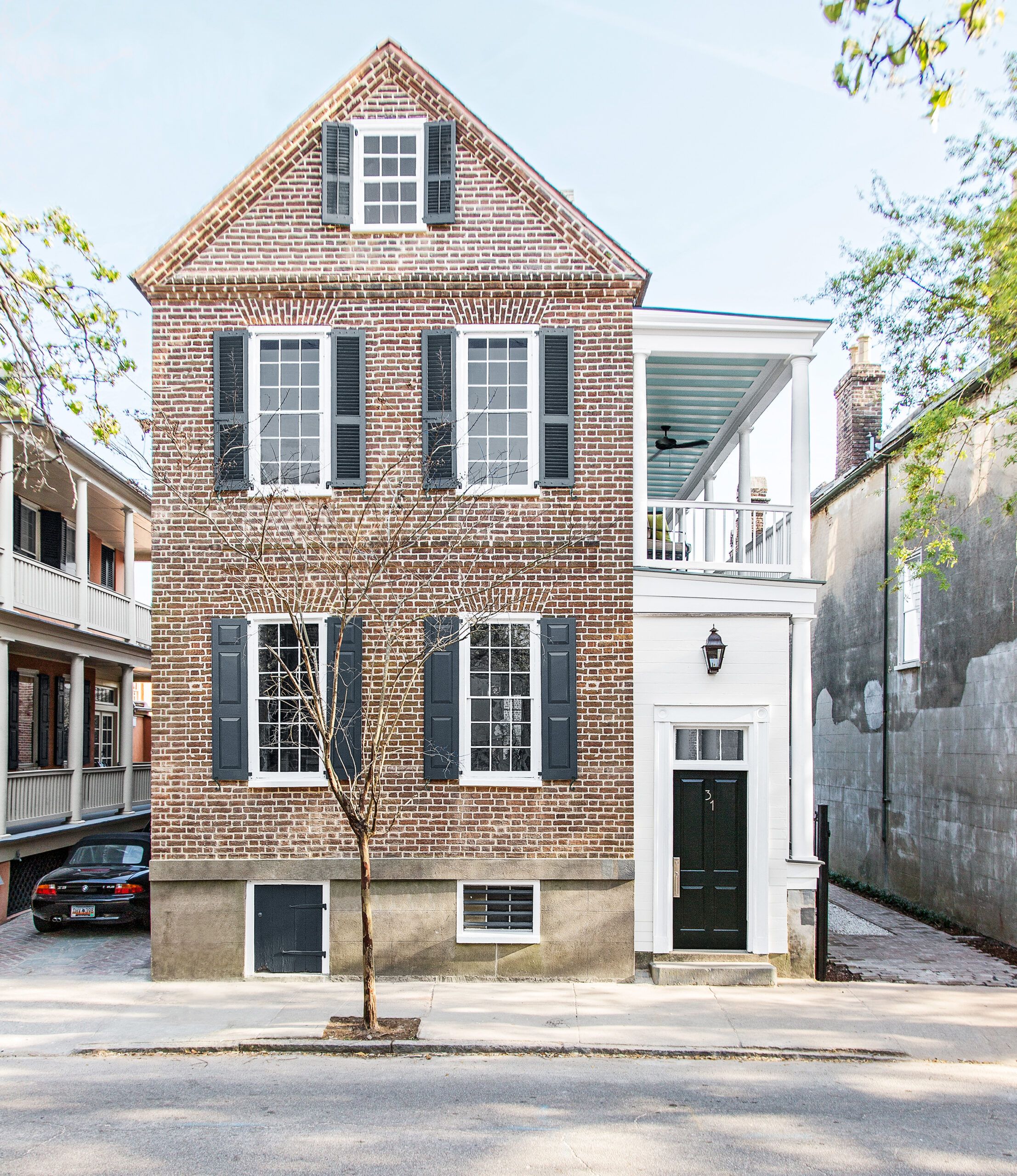
There’s no shortage of old houses to fix up in Charleston, South Carolina, but it can feel like a Goldilocks search trying to find one that’s “just right.”
Scott and Kathleen Edwards hunted for almost two years before they came across exactly what they were looking for: a house in the Ansonborough neighborhood, with its lively restaurants and shopping, that hadn’t been recently modernized.
They first moved to the city from Michigan almost 25 years ago, then raised their children in the suburbs. Three years ago, they rehabbed a house downtown as a long-term rental, and found themselves bitten by the renovation bug. With their then 18-year-old daughter off at college and their son not far behind, they liked the idea of moving back to the city, to a house with history.
Shown: As is typical of Charleston single houses, this 1840s example is one room wide, with first- and second-floor side porches, or piazzas, that run the full length of the house. The front entry awaits new lap-board siding.
The Edwards Family
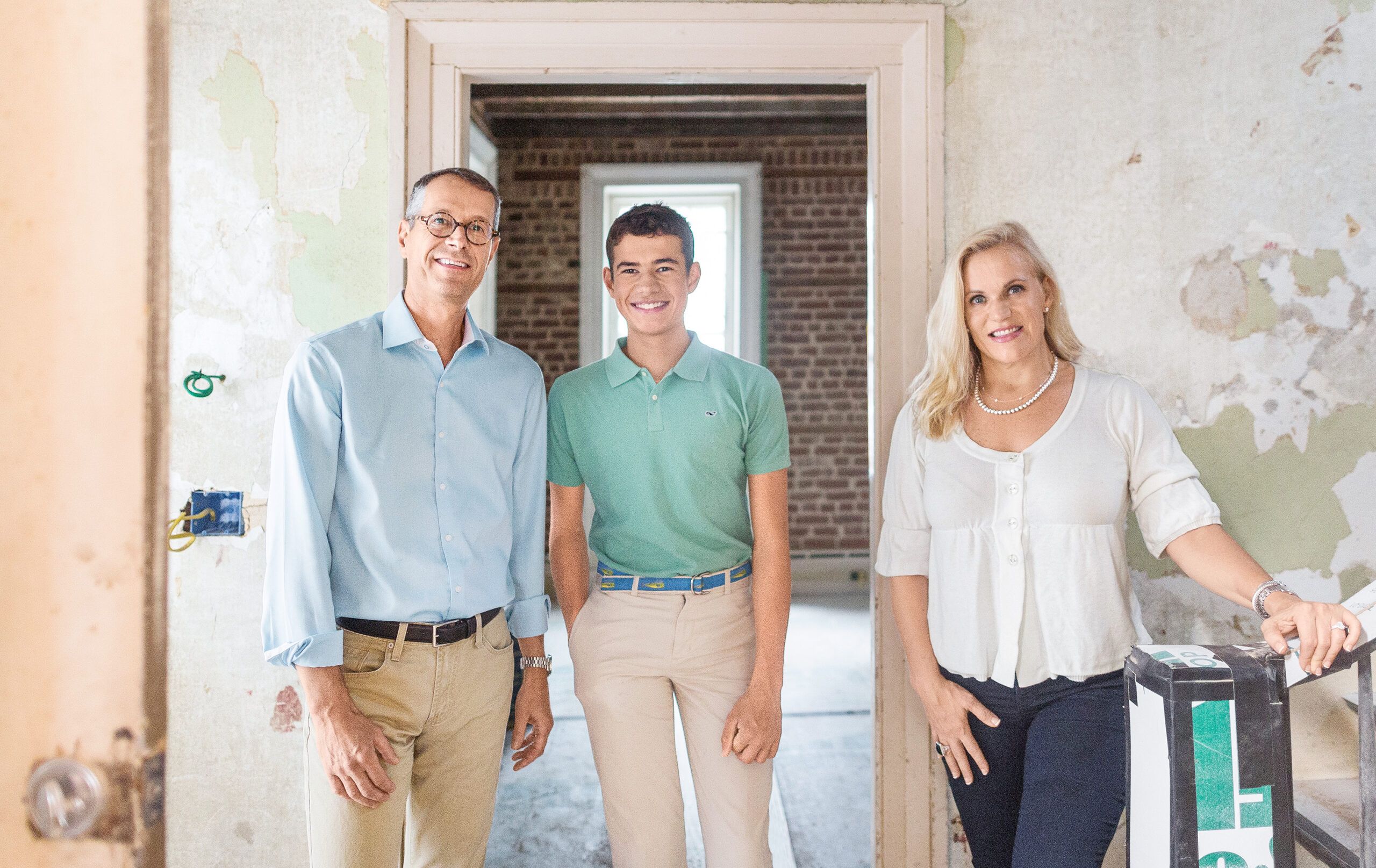
After losing one place to another bidder, they bought a for-sale-by-owner property from an estate. The house had been in the same family for 80 years. “It was just what we were looking for,” says Scott. “Not much, if any, work had been done in a long time.”
The house’s lines were a draw too. “The moldings and trim are simple and clean, almost minimalist,” Kathleen says. “But there’s also an elegance that attracted us.” Being chosen by This Old House for its 39th television season made it more perfect still.
The couple knew all along that they wanted a brick house—something Ansonborough is known for, with many built after the fire of 1838. According to a local newspaper report at the time, the fire leveled “at least one-fourth of the centre of our beautiful and flourishing city.” Afterward, the state’s general assembly gave construction loans for fire-resistant masonry buildings.
Shown: Homeowners Scott and Kathleen Edwards, with their 15-year-old son, searched for two years to find the perfect unrestored house to make their own.
The Kitchen House
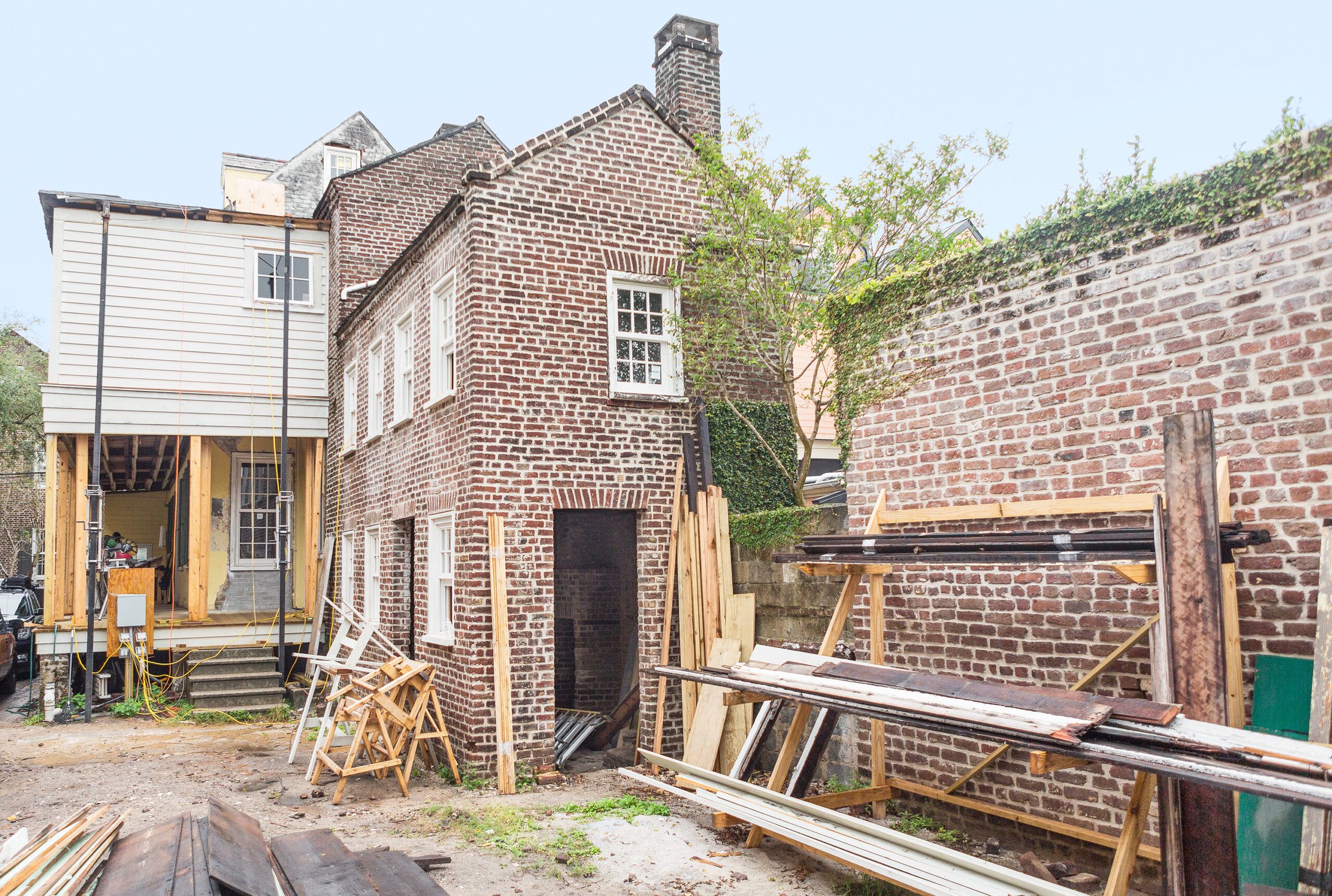
The Edwardses’ 1840s home is known as a single house, an indigenous Charleston style built to fit the city’s long, narrow lots, with the gable end facing the street. The 1,925-square-foot main house’s floor plan is typical: one room wide with two rooms on each floor and a central staircase. On the first floor, a parlor fronted the street with a dining room to the rear; at some point, a powder room was added behind the stairs. Two bedrooms occupied the second floor, with a garret on the third. “We wanted a single house,” Scott says, “mainly for its manageable size.”
Shown: The kitchen house, a smaller, once-detached building at the rear of the property originally used for food prep and laundry, will become the dining room, with guest sleeping quarters and a bath above. On the first-floor piazza, temporary supports stand in for the original wood columns, which were removed for restoration. All the exterior brick walls required repointing.
Piazza Workshop
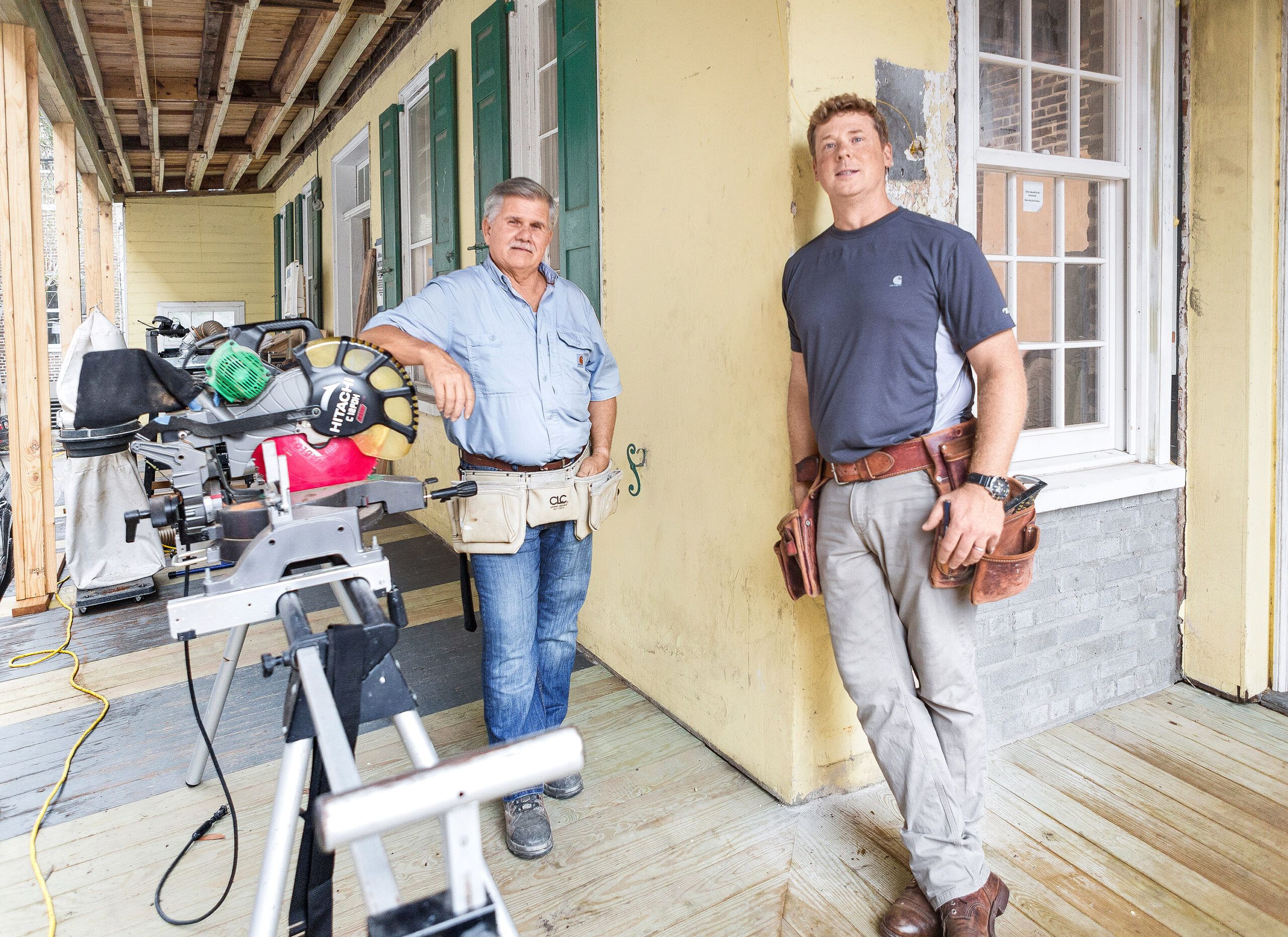
Charleston single houses have two-story open-air porches, known as piazzas, which run the full length of the house, and are built on the south or west side to take advantage of prevailing breezes. Another nod to Charleston’s hot, humid summers is high ceilings—10 feet on the first and second floors of the Edwards house.
In most 19th-century Charleston households, cooking was relegated to a detached building, or kitchen house, behind the main residence. Kathleen and Scott’s kitchen house retains its two fireplaces, one originally used for food preparation and the other for laundry.
Shown: Standing at the front of the first-floor piazza, TOH general contractor Tom Silva and TOH host Kevin O’Connor strapped on their tool aprons to help get the job done.
Original Staircase
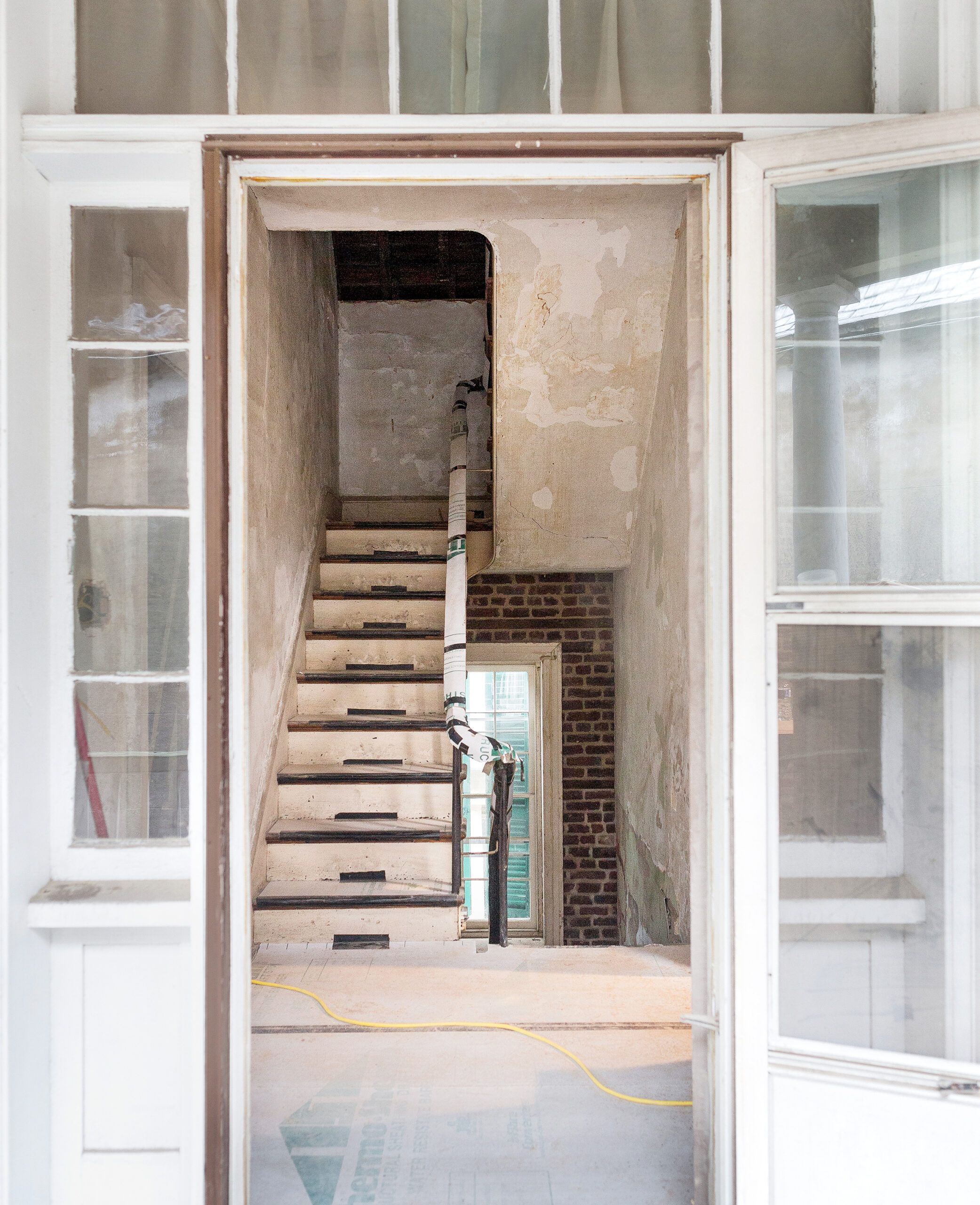
Some time prior to 1884, a two-story brick connector was built to join the main and kitchen houses. When the Edwardses bought the property, there was an outdated kitchen downstairs in the connector, and the house’s only full bath was upstairs in a lap-sided bumpout. There was no interior door to the kitchen house.
Shown: The door from the second-floor piazza opens onto the original staircase. The full-length porches on the first and second stories were designed to catch breezes during Charleston’s humid summers.
Spiffed Up and Polished
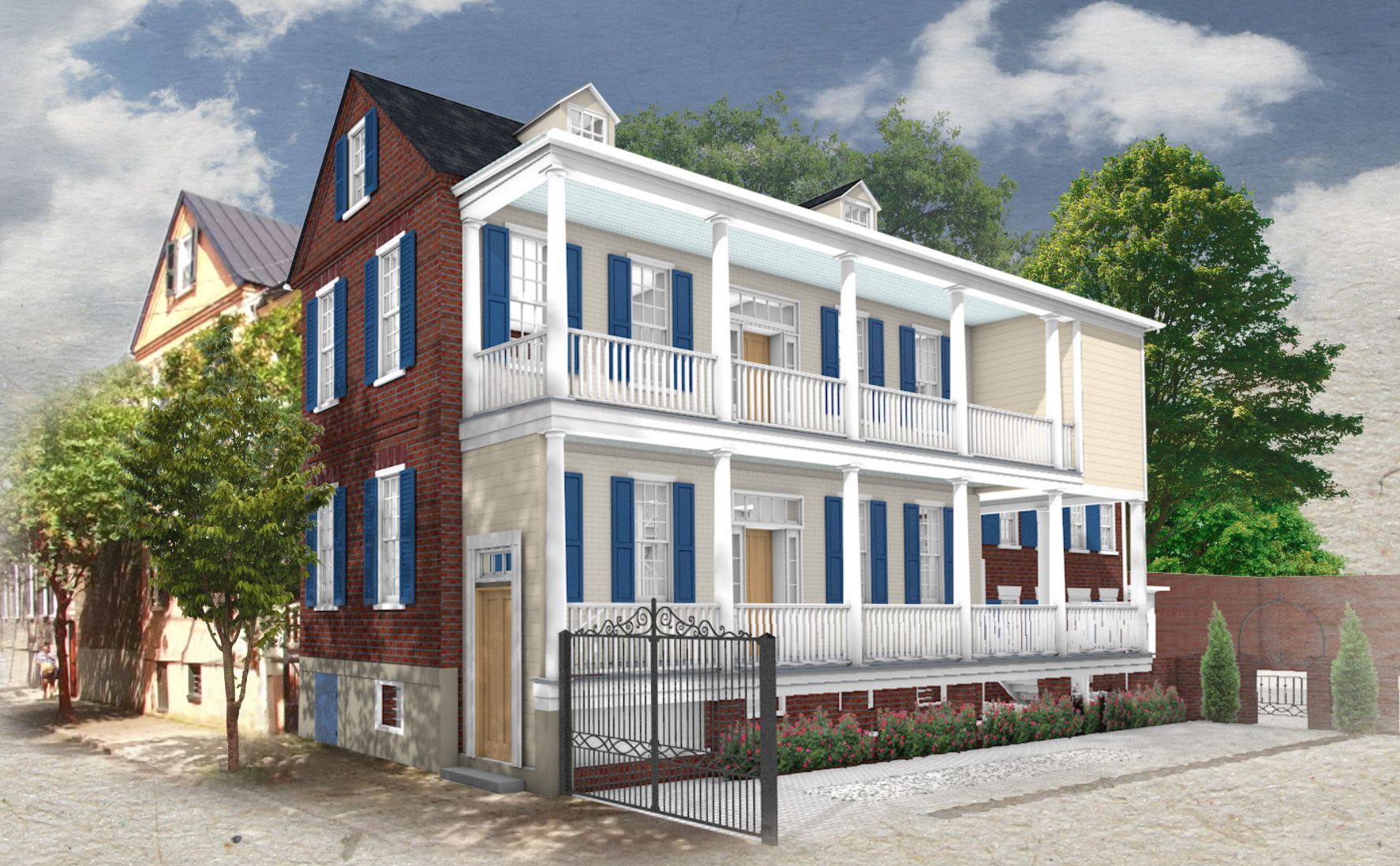
For their design work, the Edwardses turned to architect Bill Huey, who has been practicing in Charleston since 1987. He knows about the city’s fortunes and also its not-so-fortunate times. “Charlestonians have always cared about their old homes,” Huey says. “As the saying goes: ‘People might have been too poor to paint their front door, but too proud not to polish the brass hardware.’ ” Huey also knows his way around a renovation in a historic district; he serves on the city’s Board of Architectural Review (BAR), which has to approve any changes that will be visible from the street.
Shown: A computer rendering shows the renovated house with its exterior restored. Alterations to the interior floor plan and a remodeled connector that opens directly into the old kitchen house will yield a three-bedroom, three-and-a-half-bath home with 2,737 square feet of living space.
Salvaged Wood Paneling
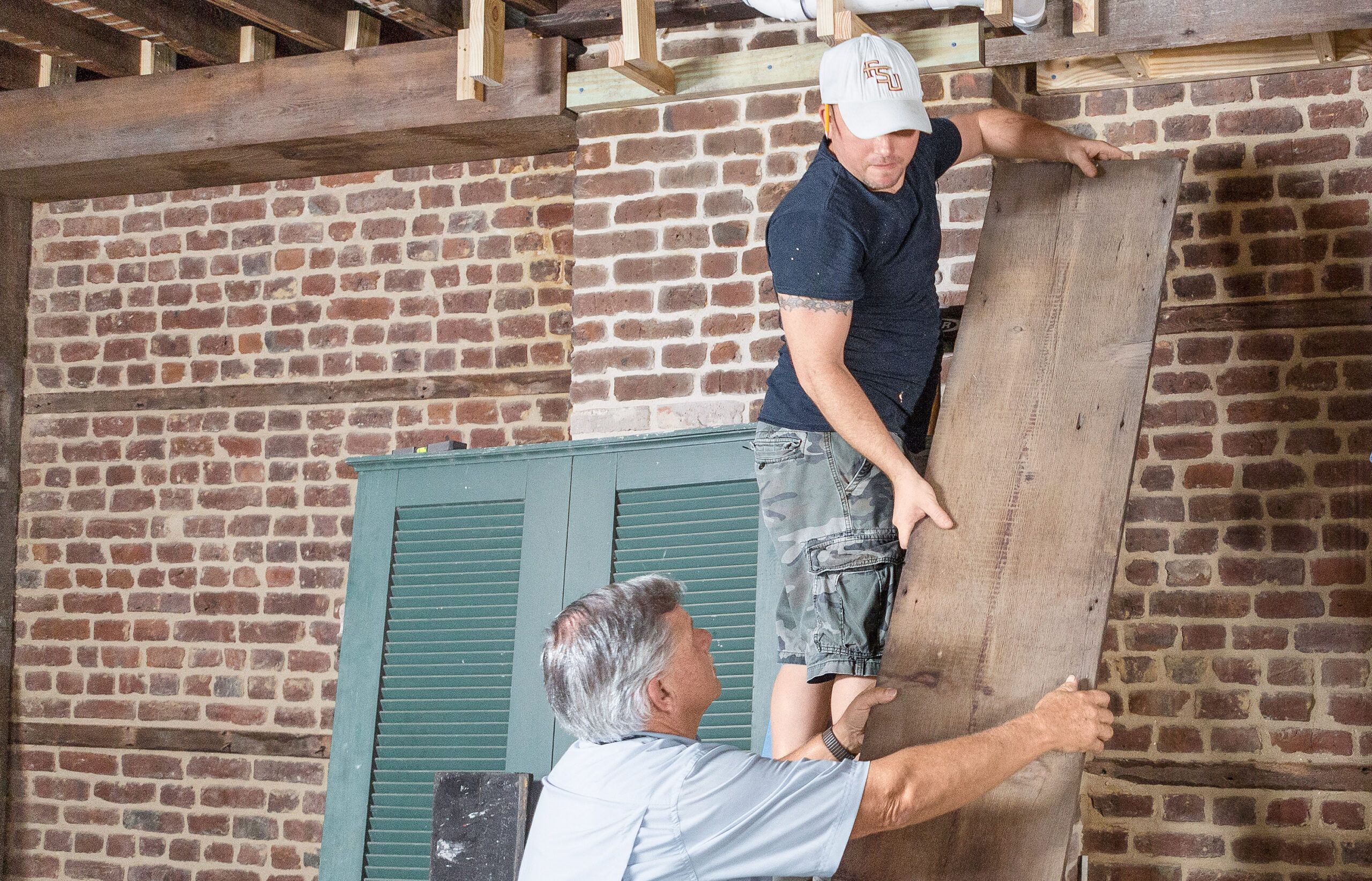
Work on the Edwardses’ house started with repointing all the brick and restoring the windows. On the third floor, some double-hungs had to be replaced with casements to provide egress for the planned bedroom, as required by code. “It’s a balancing act between the BAR and the building department,” Huey says. “Both sides understand that occupant safety is critical.”
Shown: Tom Silva and local carpenter Mike Collins reuse some of the house’s original wood paneling to build a false beam to hide new plumbing pipes for the second floor.
Exposed Brick
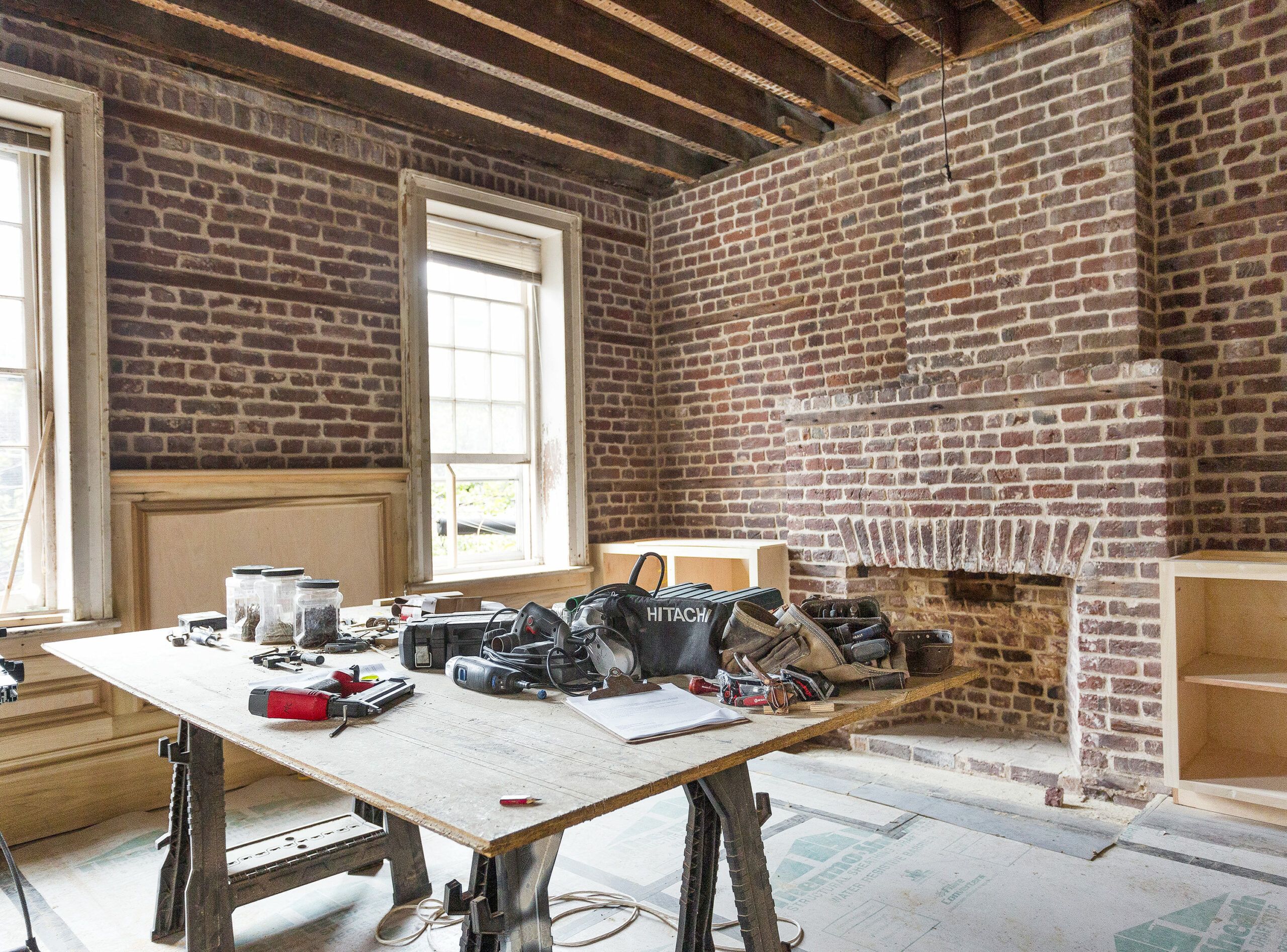
The biggest changes will take place inside the house. Charleston contractor Mark Regalbuto has worked on many historical homes, several with Huey. “We always have to make room for bathrooms and closets,” Regalbuto says. “Along with that comes the challenge of updating the floor plan for a contemporary family.”
Shown: Removing the plaster and lath exposed the interior brick walls. This street-side second-floor bedroom will become a library with new wainscot and built-in cabinetry and bookshelves.
Heart-Pine Flooring
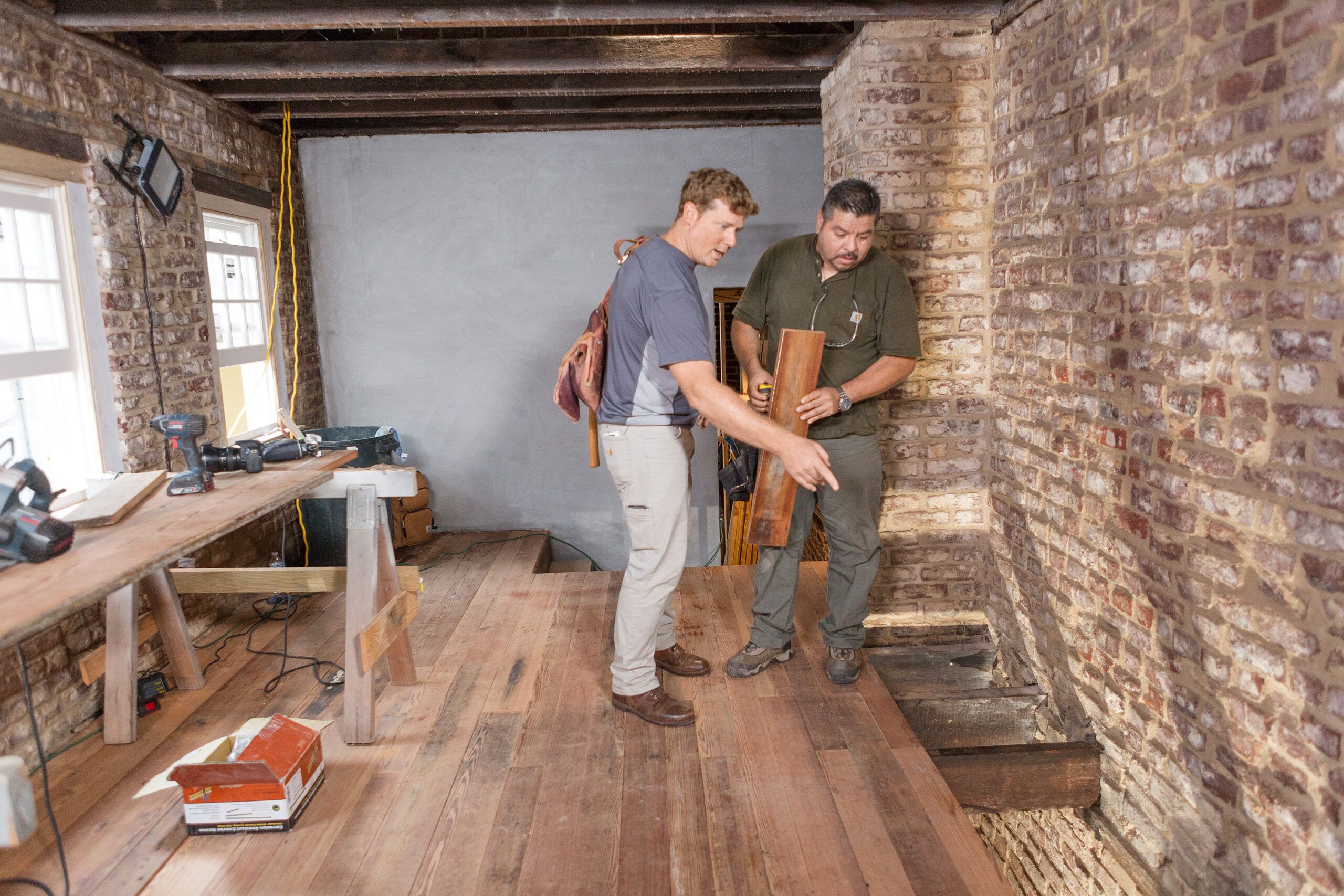
Huey’s design calls for altering the interior spaces within the existing footprint, with the original dining room becoming the new centrally located kitchen. The kitchen house in back, located six steps below the main house’s floor level, will become the dining room, with a built-in wet bar and wine storage. “We’ve always eaten our dinners in a dining room,” says Kathleen. “But breakfast and lunch happen in the kitchen.”
Shown: Kevin O’Connor and Charleston carpenter Ishmael Medina install flooring in the kitchen house’s upstairs guest room. The hefty 1½-inch-thick heart-pine boards, butt-jointed and screwed in place, are laid without a subfloor, as is typical in 19th-century Charleston houses.
Knee Walls
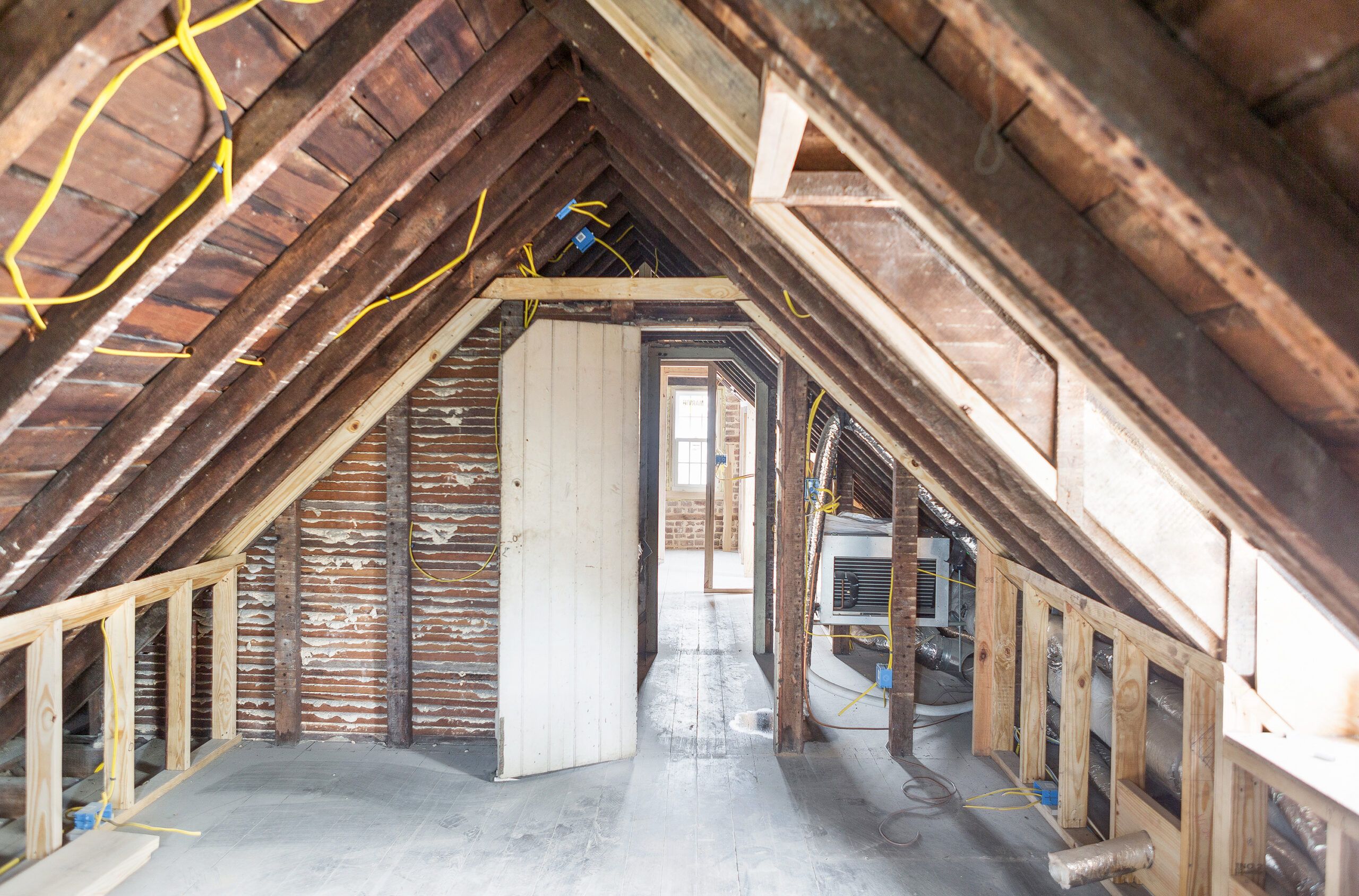
The new kitchen will have an island large enough to accommodate everyone—Scott, Kathleen, their son, and their daughter when she’s home from school. There is lots of pantry storage and a built-in coffee machine. To maximize space in the room, the range will slide into the original fireplace alcove.
The second-floor street-facing bedroom will become a library/office with bookcases, wainscoting, a media cabinet, and Scott’s desk. Down the hall, the master bedroom will lead to a new walk-in closet and master bath.
Shown: HVAC ducts and other utilities will be hidden behind newly framed knee walls in this third-floor bedroom and in the bathroom on the other side of the stairwell.
Window Updates
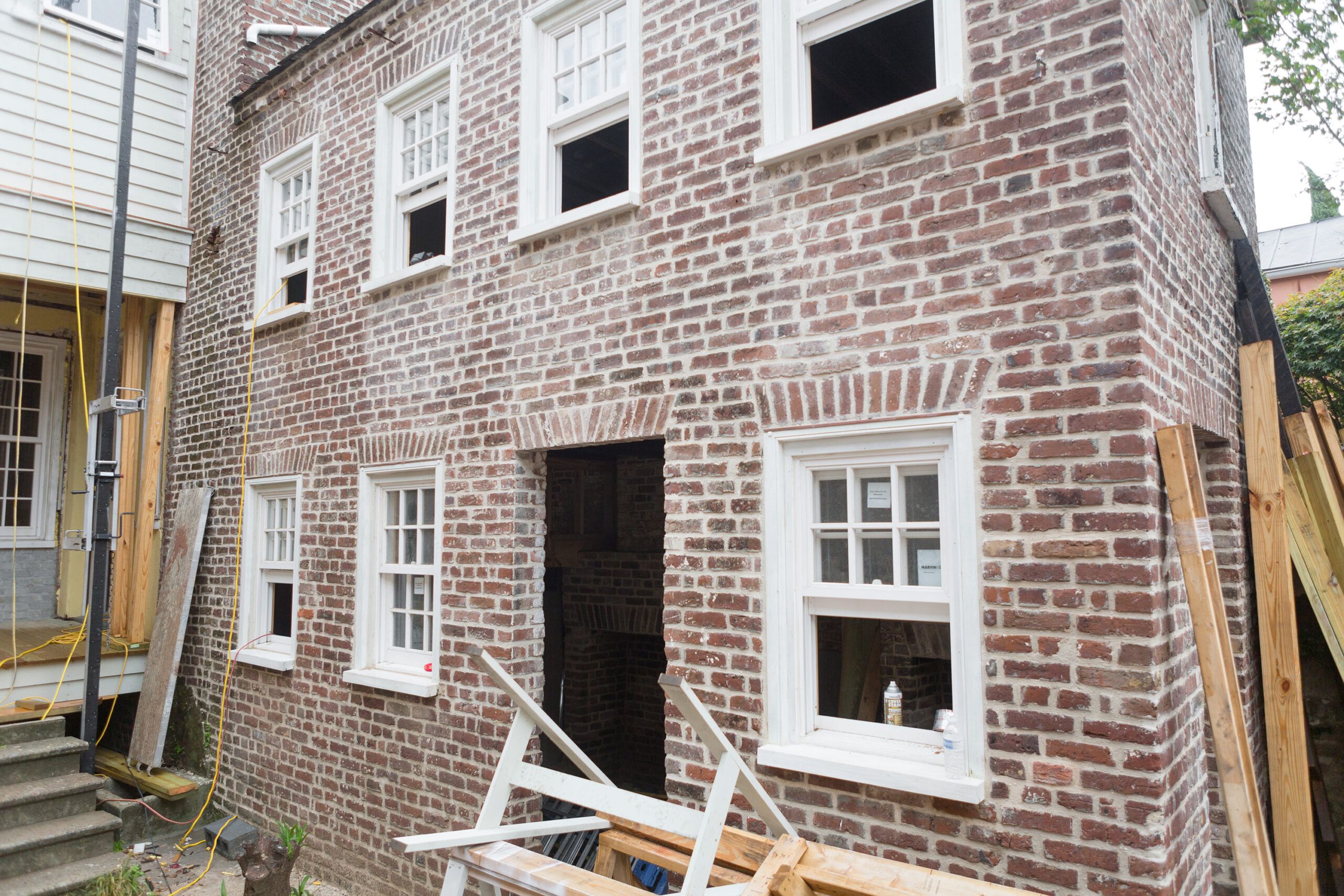
The Edwardses’ son will get the third floor virtually to himself. On the street side, his new bedroom will have a built-in full-size bed, lots of shelving, and a large closet in the hall. In the rear will be a full bath with more built-ins. He’ll share the space with HVAC air handlers that will be tucked behind knee walls and utility-closet doors.
Shown: The kitchen house’s exterior brick walls were repointed with historically accurate lime-based mortar. The six-over-six wood windows were replaced.
Rafter Replacements
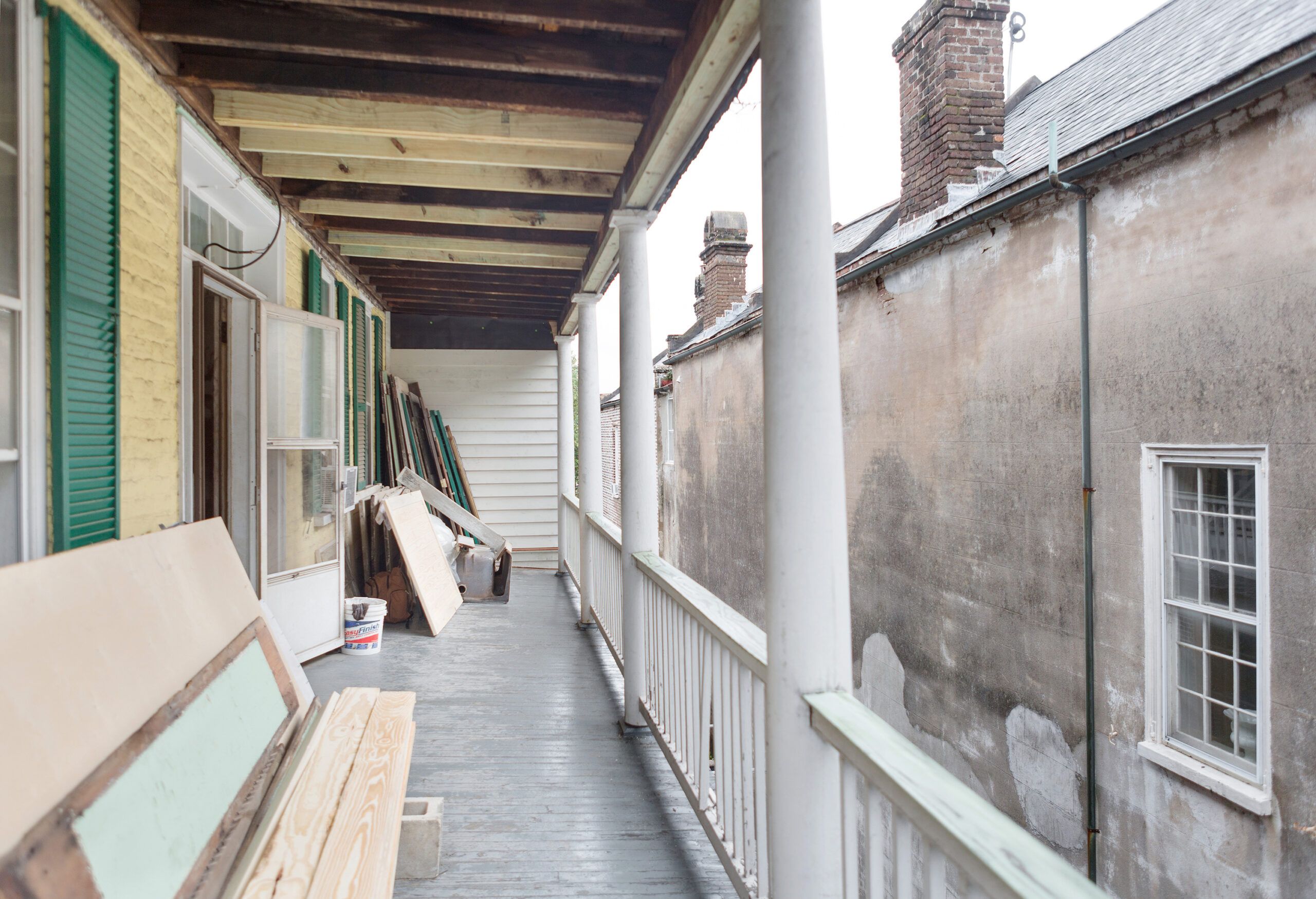
In another nod to contemporary living, the connector between the main house and the kitchen house will hold a stacked washer and dryer behind double doors, a clothes-drying rack, and a built-in desk.
Shown: Rotted and broken rafters on the second-floor porch roof have been replaced with new 2x6s.
Flooring Polish
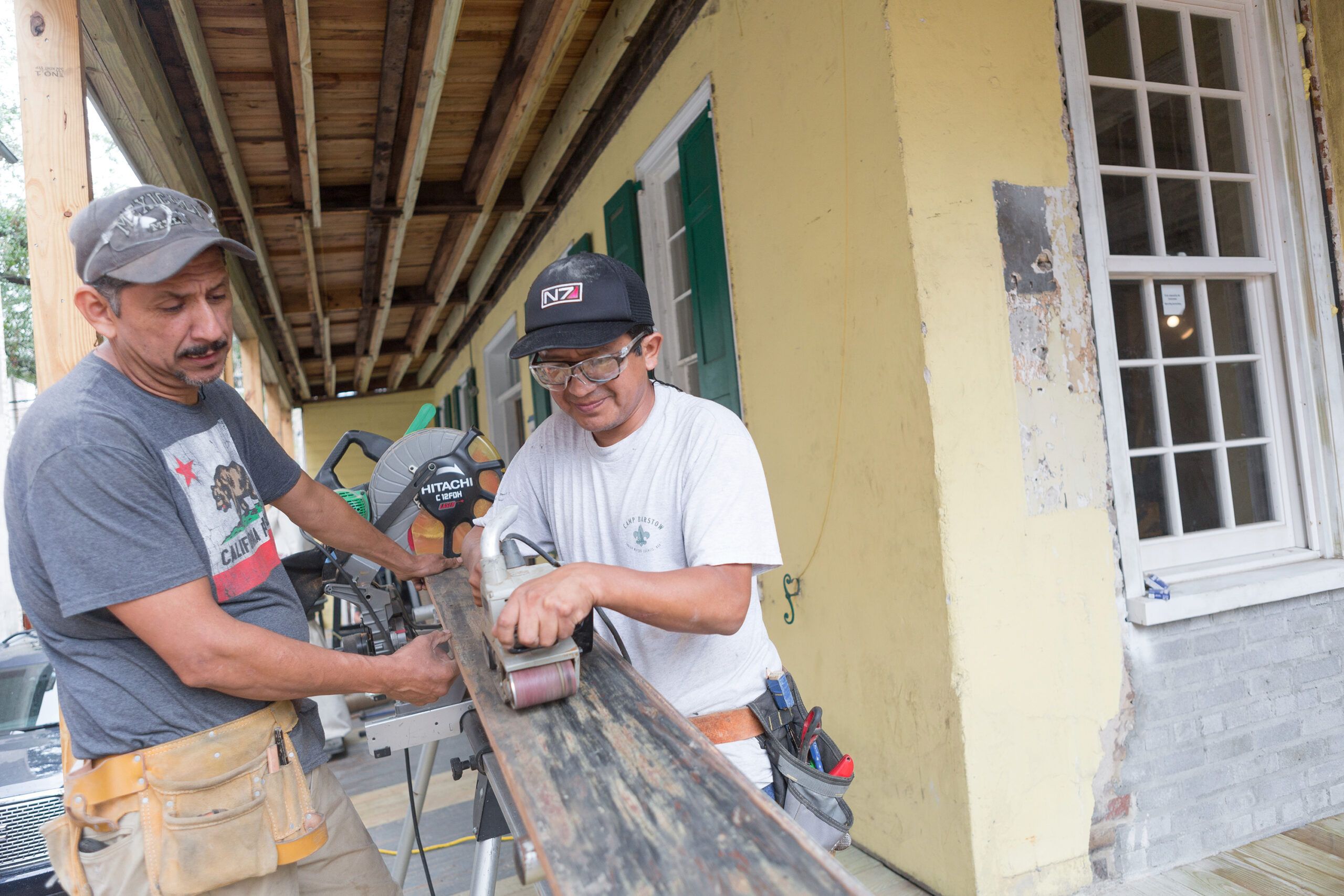
With Charleston’s mild winters and notoriously sticky summers, heating is not much of a concern, but air-conditioning is. TOH plumbing and heating expert Richard Trethewey spent considerable time engineering three separate systems for the house, one for the first floor, another for the second and third floors, and a third for the kitchen house, which will have a sleeping loft with a bath upstairs. “When you look at this house in this climate,” Richard says, “what you’ve got is basically a big brick oven that needs cooling.”
Shown: Local carpenters Samuel Medina (left) and German Madrid use a belt sander to dress a heart-pine plank for the flooring on the second story of the old kitchen house.
Partition Plaster
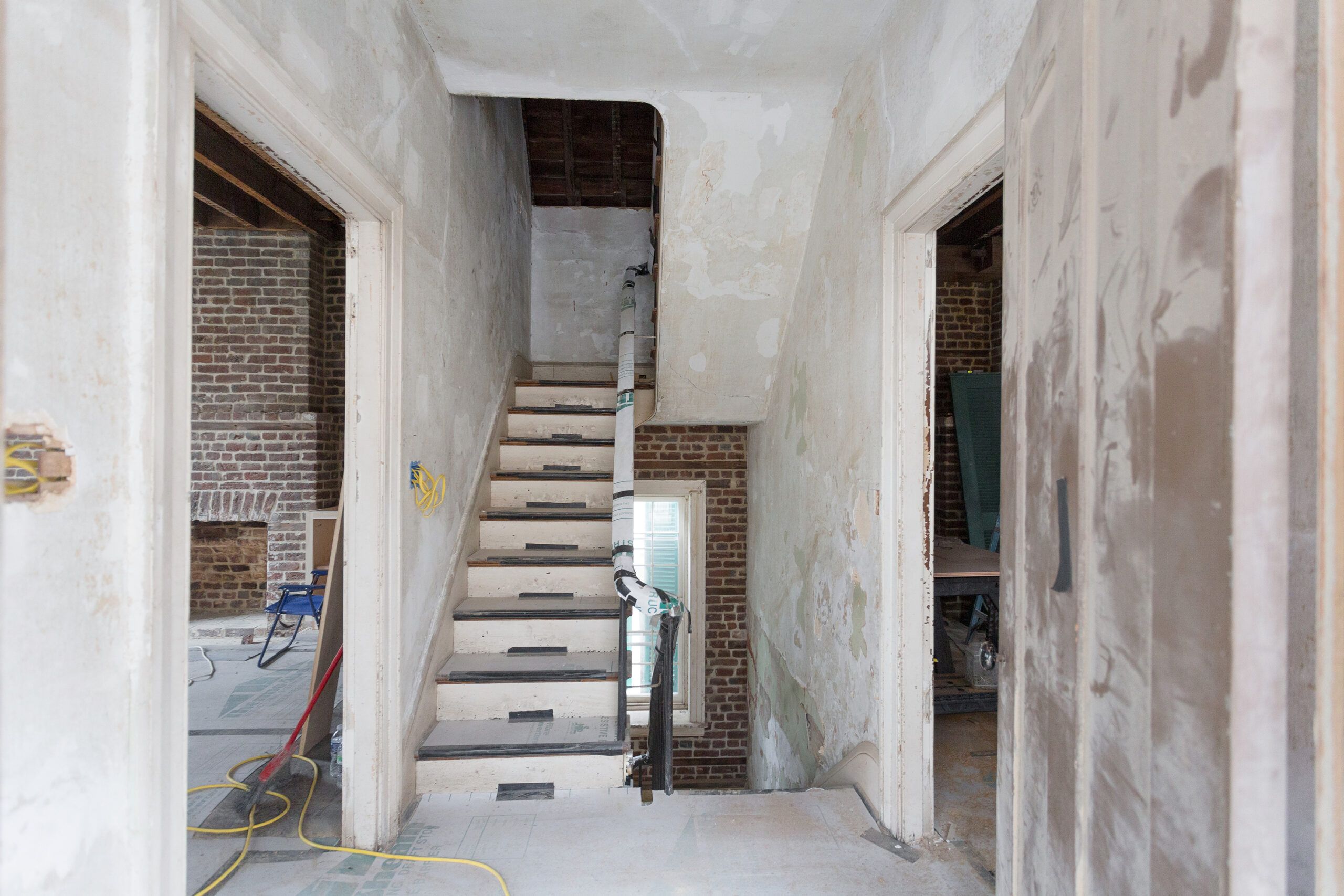
With construction under way, hiding HVAC ductwork and other utilities on the first and second floors has been cause for some head scratching, because the plans call for removing the plaster and lath on the perimeter interior walls to uncover the original brick. “Usually we run wires and plumbing behind the plaster,” says TOH’s Tom Silva. “With the bare brick, we are having to look for alternate routes for almost every wire and pipe.”
Shown: Although the perimeter walls of the house will be exposed brick inside, the interior partition walls—including the ones here, which define the second-floor stairwell—will retain their plaster.
Remilled Flooring
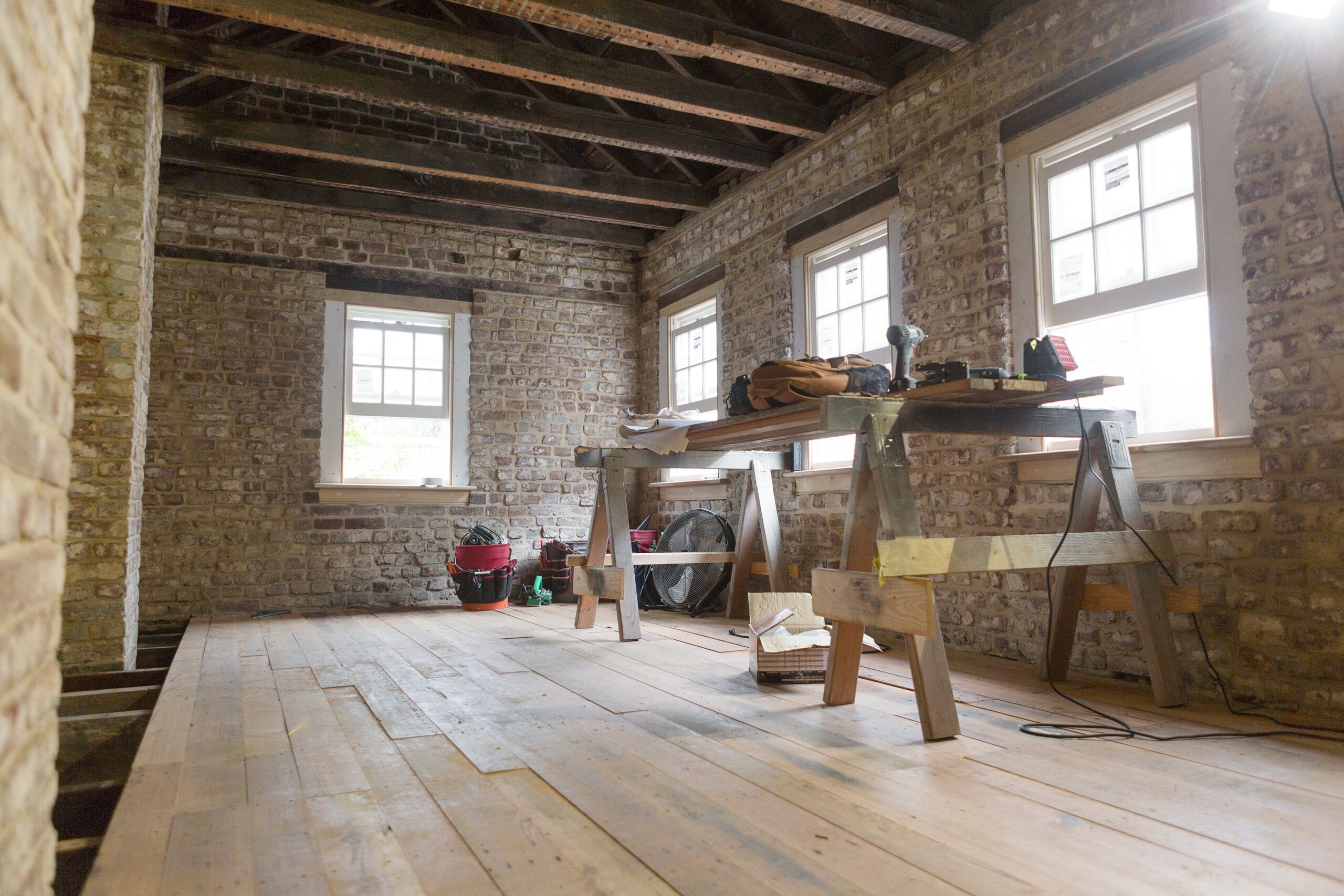
Removing the plaster and lath also leaves a 2-inch gap between the back of the casings and the brick. “We’ve tackled this in other Charleston houses,” Regalbuto says. “We scribe wood fill-in pieces to fit between the back of the casings and the brick walls.” The key is not to get them too loose or too tight, to accommodate the wood’s movement with changes in the humidity.
Shown: Remilled flooring was installed in the second floor of the kitchen house, which will be used as a guest room. The space will also accommodate the couple’s daughter when she’s home from college.
Sorting the Bricks
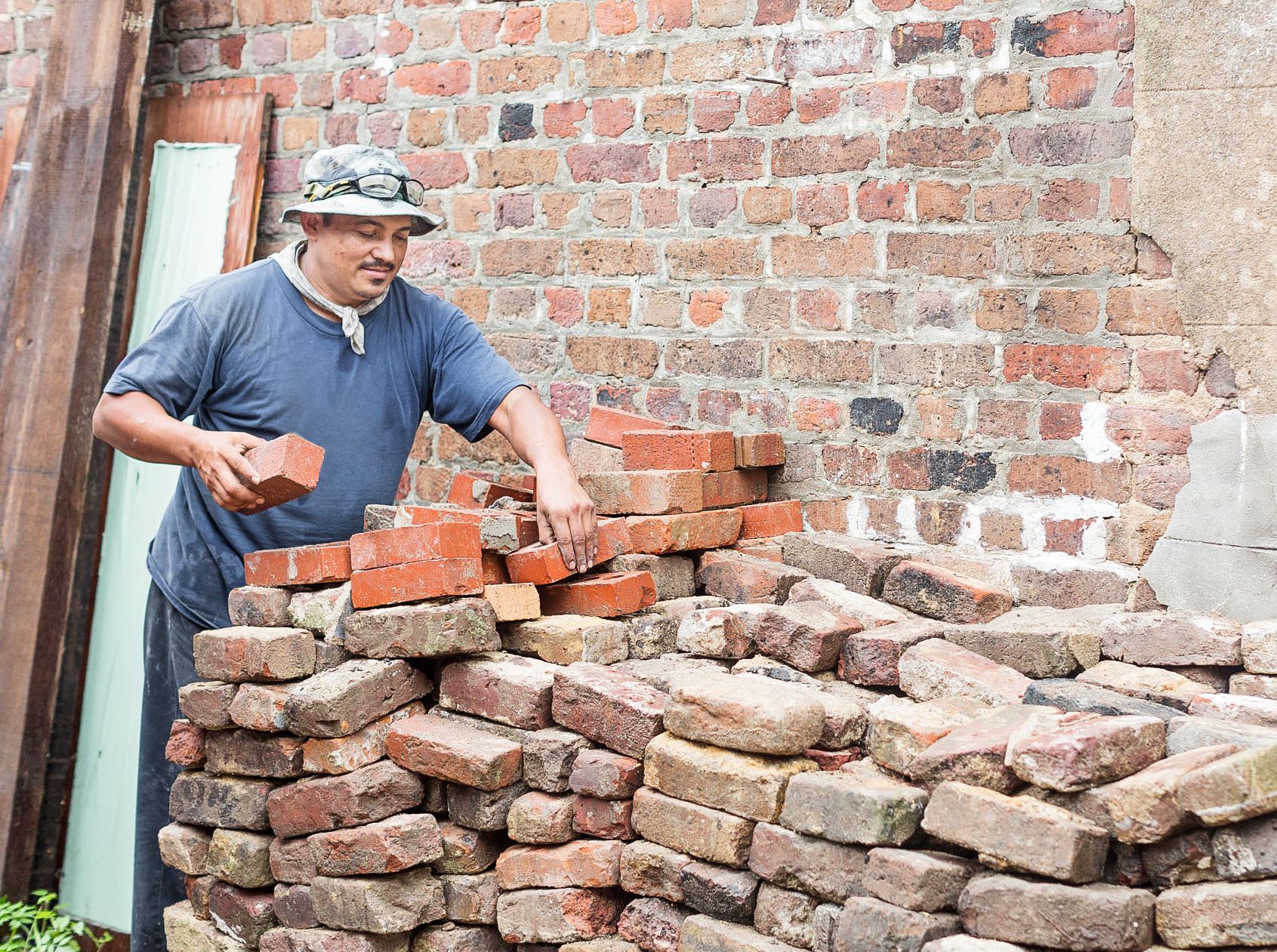
As the project progresses, the vision for the house is starting to take shape. The exterior restoration is nearly complete, while inside, the finish work continues. It’s not too fancy but not too plain; there’s a simple elegance about the rooms. “For the Edwards family,” says architect Bill Huey, “it’s going to be just right.”
Shown: Rigoberto Morales sorts through a pile of salvaged bricks, picking out the best of the original rounded-corner, handmade ones for reuse.
Fireplace Makeovers
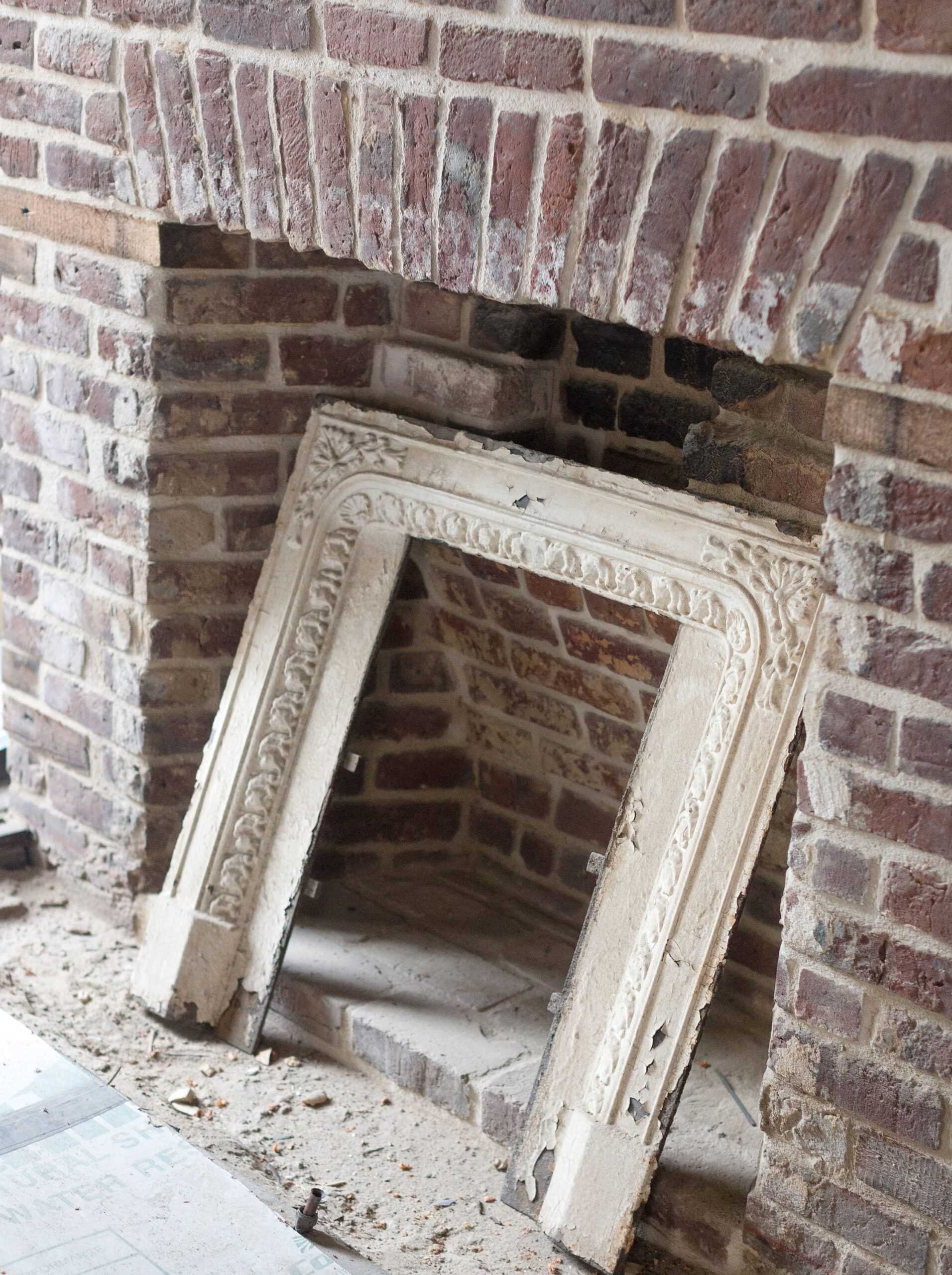
Four of the six fireplaces will be fitted with gas log sets. Some originally burned coal, and had cast-iron surrounds such as this one.
Wainscoting Around Windows
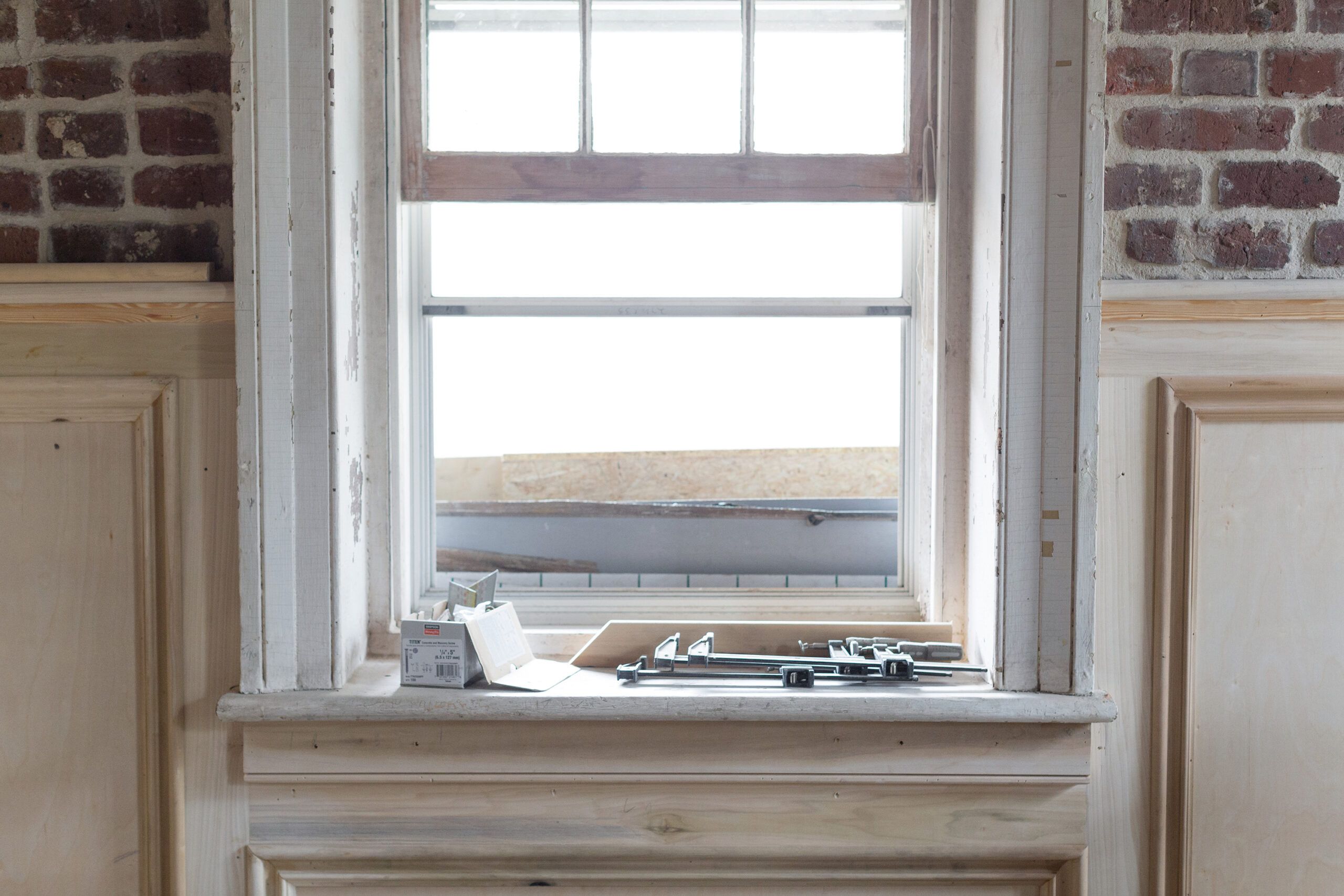
New wainscoting in the second-floor library wraps around one of the restored windows.
